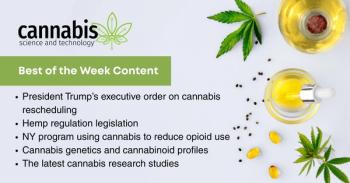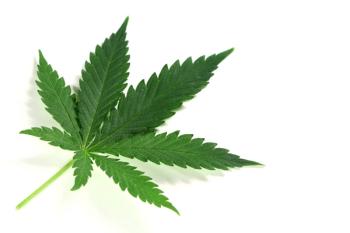
- March/April 2022
- Volume 3
- Issue 1
- Pages: 36-39
Cannabinoids in a Pill? One Company’s Research to Find the Next Cannabinoid-Based Medication
Dr. Woody, chief executive officer of 180 Life Sciences, discusses in this interview the current research surrounding synthetic cannabinoids as a treatment for chronic pain, as well as the development of a new type of medication that would have the potential to offer the benefits of cannabis without any undesirable effects.
Imagine waking up with chronic pain every day. Perhaps you take an over-the-counter medicine such as Aleve or Tylenol and that might dull the pain to a tolerable level, but it’s still there. Perhaps you are functionable, but not pain-free. Now, imagine a new type of medication that has the potential to offer the benefits of cannabis without any undesirable effects—no “high.” Dr. James Woody, the chief executive officer of 180 Life Sciences is working diligently with his team of scientists and researchers—including Dr. Marc Feldmann and Dr. Raphael Mechoulam—to develop an FDA-approved medication such as this. Here, Dr. Woody discusses the current research surrounding synthetic cannabinoids, such as cannabidiol (CBD) and cannabigerol (CBG), as a treatment for chronic pain as well as some of the other impressive projects his company is working on.
Can you tell me a little bit about yourself?
Dr. James Woody: I'm a pediatric immunologist. I trained in pediatrics at Duke University in Durham, North Carolina and at Boston Children's Hospital in Massachusetts. Along the way, I was involved in a number of immunologic studies. I also helped invent some drugs that have been used in lots of patients and have been very helpful. I ran the former Syntex Pharmaceuticals Company for eight years and then started companies on my own. Most recently, I joined 180 Life Sciences as CEO to help move products forward.
Can you tell me about the company 180 Life Sciences?
Dr. Woody: 180 Life Sciences was put together from three other companies in a three-way merger. One of the companies wasusing anti-tumor necrosis factor or anti-TNF. A second company was based in Israel and it had been working on cannabinoid compounds. Finally, the third company was developing a compound against the nicotinic acid receptor, which is anti-inflammatory, and was out of Stanford University in Palo Alto, California. I’ll explore each of these areas of expertise in greater detail.
These three companies came together as 180 Life Sciences. All of the pieces came together through a special purpose acquisition company, or a SPAC. 180 Life Sciences has been a public company for about a year now and we have made some nice progress.
What is Remicade?
Dr. Woody: Here’s how Remicade works in your blood. You have thousands of little proteins circulating around. Some of them have to do with the immune system, and those particular proteins are called cytokines. They tell the immune system to turn off, on, do whatever needs to be done to fight infection or other issues.
One of the cytokines is called tumor necrosis factor or TNF. TNF got its name a long time ago when somebody injected this particular protein into tumors and it made them go away. But, these days, it's never used for that. It turns out that TNF is considered a “bad actor.” It's a cytokine that tells your joints to become inflamed, destroy your joint tissue, or destroy your colon or bowel in patients with Crohn's disease or inflammatory bowel disease. It can make diseases worse. That's what TNF is and why it’s called a “bad actor.”
At 180 Life Sciences, Dr. Marc Feldmann, and I discovered that this cytokine TNF was causing the joint damage found in rheumatoid arthritis. We were the first to make an antibody against TNF so that we could block its activity. When it was given to rheumatoid arthritis patients, they said their pain went away and they were able to stand up. These patients were in wheelchairs, so that was a phenomenal finding.
This anti-TNF treatment for rheumatoid arthritis, Remicade, was the first of its kind, and hundreds of thousands of patients have been treated with it. It also works in patients with Crohn's disease or inflammatory bowel disease. All of those patients have improved with this drug.
Nowadays, there are five approved anti-TNF drugs in the U.S. There are probably another eight or nine anti-TNF biosimilars coming along because the market is very large. It's a $40 billion a year industry. It's the largest selling class of drugs because it has so many uses and it's so effective. Although it has some side effects, there are no patients with rheumatoid arthritis in wheelchairs in the whole world because of that drug. That's what Remicade does.
It's been quite a success story, and for the patients—patients with rheumatoid arthritis or Crohn's disease can now live normal lives, without pain.
How did you get involved in the cannabis industry?
Dr. Woody: As I mentioned, one of the three companies involved in the 180 Life Sciences merger was specializing in cannabis. My colleagues Dr. Feldmann, and Dr. Raphael Mechoulam, have been spearheading this research.
Dr. Mechoulam is probably the world's top expert on cannabinoids. He discovered the endocannabinoid system and has published several research papers on it. He’s been working with Dr. Feldmann to find a specific compound that reduces pain and inflammation, be non-addictive, and not have hallucinogenic potential. They’ve been researching this for 10 years. That research is now part of our 180 Life Sciences program.
How do you assist others in their battle with chronic pain?
Dr. Woody: Chronic pain is a severe global problem. There's probably 60 million people experiencing some type of chronic pain. Quite a bit of it is associated with inflammation. That’s when the tissue or joints become inflamed with white blood cells, red blood cells, and cytokines in the joint or in the tissue, causing swelling. That swelling presses on the nerves and creates pain. Inflammation and pain often go together.
If that pain is not too serious, it’s treated with Advil, Aleve, or something similar. Those are non-steroidal anti-inflammatory drugs. Cortisone is another option, and that has a lot of side effects. You don't want to use that unless you must. The next step up beyond that is opioids, which of course, are highly addictive. There’s a need for some non-addictive anti-inflammatory and pain-relieving substances in between the Advil and Aleve options and opioids. A cannabinoid compound could have the properties needed to address this global chronic pain problem.
How has medical cannabis helped patients suffering from chronic pain?
Dr. Woody: I think there's data to suggest that it's helpful in some patients with chronic pain. I don't know that it's as effective as, say, opioids, but it certainly seems to help some people. The data on medical cannabis and pain is a little weak. That's why we've decided to try to make a specific compound that has these properties.
The company has three ongoing programs in inflammation and pain. Can you give us a high-level overview of those programs?
Dr. Woody: We have three clinical trials in progress with anti-TNF biologic agents and they're being studied to treat pain, and fibrosis and other conditions. The three anti-TNF clinical trials are in Dupuytren’s contracture, frozen shoulder, and post-operative dementia. For our post-operative dementia study, we’re looking at how TNF is released, causing inflammation of the brain which leads to dementia. If patients are treated with anti-TNF at the time of their surgery, we believe we can prevent the post-operative dementia.
Our second program is with a nicotinic acid receptor agonist. We know that nicotine is a mild anti-inflammatory. We’re making specific medicines with this anti-inflammatory without the addictive properties of nicotine.
There are several programs aimed at treating inflammation and pain. Including the cannabinoid compounds that we're developing, we hope will be effective for both reducing the inflammation and the pain, and we have some data to suggest that we can do that.
Can you tell us about your synthetic CBD analog program for inflammation and pain?
Dr. Woody: The cannabis available at a dispensary can have more than 100 compounds in it Some of them are good, some of them are not so good. Some of them lead to side effects. But it's not a very pure agent.
It's time for us to figure out what's the best active ingredient and then figure out which specific compound gives you the effect that you want. And that's what we've been working on with Dr. Mechoulam. He's been able to create very specific compounds that have the desired effect. They have the benefit of being orally absorbable. Most of the cannabis sold at dispensaries is not absorbable orally. If we can make a pill out of this, we hope it will be highly specific for the tissues where relief is needed. We also hope it will be non-addictive and be able to reduce both inflammation and pain.
We've been working on this for five or six years, and we have compounds that seem to have the right characteristics. These will be synthetic, they’ll be made in a laboratory, and be very pure. Those are the requirements that the Food and Drug Administration (FDA) wants for a new medicine. All those things fit together and make a lot of sense. It's something I've done several times before in making new medicines.
Since you said that you would be creating them synthetically, is it a complex process?
Dr. Woody: When you're forming a new chemical entity, there are certain processes used to make sure that what you get at the end is uniform and it's exactly what you want. Our scientists have worked all of that out and determined how to make this medicine with three, four, or five chemical steps. They purify it, and we test it.
What makes this a novel use of CBD?
Dr. Woody: Most of the cannabinoid compounds in cannabis are not orally absorbable. That means you can't take it orally, you must either smoke it or inject it. We’re developing a pill. We are trying to do that by making specialized salts of CBD compounds. That makes them so that when you take them orally as a pill, they get into your blood system at the level that we want. Getting to this point has been quite a difficult process. We still have several programs ongoingto pinpoint the best of these compounds.
Why use a synthetic analog, rather than a naturally occurring compound?
Dr. Woody: In looking at the natural compounds, you have 100 different molecules. Trying to figure out which is the one or two that have the most beneficial effect is very challenging. And we've decided to approach it from the other direction using specific compounds that we think would be the right ones for the properties that we want. The synthetic compounds can be created in a lab and undergo testing, and can be reviewed by the FDA for approval. The FDA doesn't like compounds that are made up of hundreds of compounds as a mixture because it’s difficult to determine which compound is the active one.
It's a favorable way to do this and then have a real medicine that works and is dependable, reproducible, and able to help the patients. In due course, we'll talk with the FDA when we get all the data together. I think the non-addictive indication will probably be in our favor. However, it’s unclear as to where these trials will take place, as it’s a couple of years off.
In 2021, 180 Life Sciences
Dr. Woody: The way the process works is that many different compounds are identified that are slightly different. The chemistry of each one of them is examined. Then the compounds are tested in animals, usually mice or rats, for effect on inflammation and pain. We've taken a whole series of these compounds to look at effectiveness in both pain and inflammation.
From that, we picked out one compound, HUM-217. It took our team about a year to do this kind of selection of our first lead candidate. There may be more that are better. But for the moment HUM-217 is the one we're working on. We were able to show in animal models that it reduces the inflammation that keeps the inflammatory blood cells, from going into the joints and other tissues. It also is effective in pain, and it eliminates the damaging cytokines that are produced with inflammation. Those are all properties that we were looking for.
A
Dr. Woody: I think the paper presented data that the compound had the benefit of stopping the inflammatory blood cells from going into the tissues and causing the inflammation. It was also effective in pain reduction, and it reduced the cytokines IL-1 and IL-18 that caused pain and inflammation. It had other properties that we liked. All those things go into trying to select the best lead candidate.
What are the next steps in the development of the synthetic CBD analog program?
Dr. Woody: We’re involved in the regular drug development process called preclinical testing. It leads to a pre-investigational new drug application (pre-IND) with the FDA. To test a drug in humans in the U.S., an investigational new drug permit with the FDA is filed.To reach that point, you must complete studies on the drug before you take the proposal to the FDA to say, ‘okay, we think this is safe enough to be able to start administering to patients.’ This involves making sure a compound is not toxic in a variety of doses, and how much of it you can give to a person or an animal. Does it have side effects or toxicities? Is it safe and is it effective? Does it really reduce the inflammation and pain that we're describing? Is it absorbable? How much of it is absorbed? How much do you have in the blood? How much do you need to get the effect of reducing pain and inflammation?
The FDA wants all of those are questions answered. That's one part of this pre-IND application. The second is how to manufacture it. It has to be made under very specialized conditions called good manufacturing practice (GMP). Every step of the production of this must be described in detail. The FDA reviews all of this, and make a decision before studies begin with human patients. That regulatory oversight is present not just in the U.S., but in the European Union, the UK and Israel—everywhere really. All the regulatory agencies follow pretty much the same path.
To do these pre-IND enabling studies takes probably a year. It's a long process, but these are the— if you compare it to the Olympics—these are the compulsories. This is what you have to do. It's complex, but we have been through it quite a few times so we know what to expect and how to manage issues that come up.
What would you like to see change in the cannabis industry over the next 5 years?
Dr. Woody: I think that cannabis has some useful aspects. It’s effective in treating pediatric seizures. I think it's helpful in treating post-traumatic stress disorder (PTSD). I'm quite familiar with that because I was involved in the Veterans Affairs (VA) PTSD programs. I think to have purified compounds that don't have side effects would be good for the whole industry rather than the mixtures that they're currently using.
180 Life Sciences is not alone in working on this. I see that as a big plus. We're particularly focusing on inflammation and pain. Others are focusing on these other indications such as seizures, post-traumatic stress, and other kinds of anxiety. I think if the right compounds are made, these could be quite attractive and helpful to people without any of the major side effects.
Can you discuss your work on PTSD and the VA a little more?
Dr. Woody: Before I joined the biopharmaceutical and biotech industry, I was in the U.S. Navy as an immunologist. I ran an infectious disease facility in Cairo, Egypt for 4 years, working in infectious disease detection all over eastern Africa.
During the first Gulf War, my team was sent to the Gulf region because we had a thorough understanding about all the infectious diseases in the area. Many men and women in both the Marines and Army were exposed to toxins, radiation, fumes from burning oil, explosions, pesticides, and other hazards.
About a year-and-a-half ago, because of my experience, I was asked to join the VA research group on PTSD. These are disabled Gulf War Syndrome patients. So, I've been working with them for about a year investigating what caused their condition and potential therapies for these desperately ill veterans. They have a whole range ofpeculiar diseases, and many are suffering from Gulf War Syndrome.
We're trying to come up with beneficial treatments for them. Cannabis is one of them.
Does 180 Life Sciences perform research studies using cannabis?
Dr. Woody: Yes, we’re trying to find out the most potent compounds in cannabis. One problem with the whole cannabis and cannabinoid industry is that no one quite knows how these compounds work. We have concepts and ideas about which receptors they bind to and which particular metabolic pathways they influence. But no one's been able to pin down exactly how they work— even Dr. Mechoulam. We are looking for the best ones we can to produce the clinical effect that we want. That's the research that we're doing.
Is there anything else you would like to add?
Dr. Woody: The plan for our compounds is going forward. We know that when we treat rheumatoid arthritis patients with anti-TNF, we can control the inflammation, but a lot of them have pain that goes along with it. If we can find the right compound, we see that this would be a good place to test it in these patients with arthritis who have persisting pain.
If we can relieve that and even reduce the inflammation a little further, that would be highly desirable because there are a lot of these patients who need new, non-addictive options.
References
Articles in this issue
over 3 years ago
March/April 2022 Digital Editionover 3 years ago
Chronic Pain: Data Snapshotover 3 years ago
Overview of Research on Cannabis for Chronic Painover 3 years ago
Finding Relief with Cannabisover 3 years ago
Eyewitness: Cannabis Should Be the Chronic Pain Treatment Choiceover 3 years ago
Chronic Pain Advocacy: It’s Time to Testify!Newsletter
Unlock the latest breakthroughs in cannabis science—subscribe now to get expert insights, research, and industry updates delivered to your inbox.




